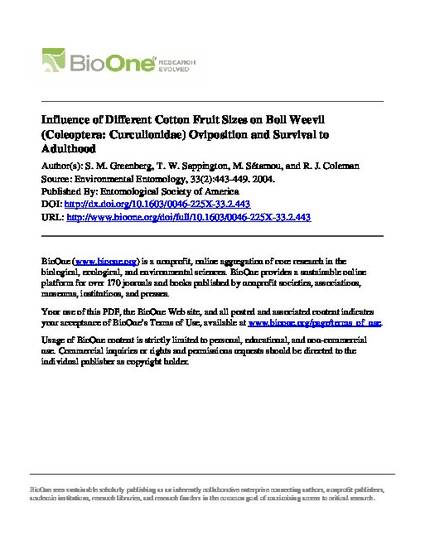
Understanding the critical host plant factors that determine oviposition behavior and survival of boll weevil, Anthonomus grandis grandis Boheman, on cotton, Gossypium hirsutum L., is important for developing successful pest management strategies. However, published information is both conflicting and limited regarding how different cotton fruit sizes affect boll weevil oviposition choices and subsequent larval survival to adulthood. Consequently, we used a standard based on fruit size diameter to evaluate boll weevil feeding and oviposition punctures, and survival to adulthood on 10 different cotton fruit sizes: squares of diameter 1.5–2.0 (pinhead), 3.0–3.5 (matchhead), 5–6, 7–8, or 9–10 mm; candle; and bolls of diameter 10–15, 15–20, 20–30, or >30 mm. Oviposition and feeding punctures were significantly affected by cotton fruit size. Females did not oviposit in pinhead squares. The fewest eggs were oviposited in boll sizes >30 mm. The highest number of eggs was recorded in square sizes of 5–6 and 7–8 mm. Boll weevil survival to adulthood was highest on square sizes of 7–8 or 9–10 mm (58.6–59.7%). No survival occurred in matchhead squares or bolls >30 mm. Duration of development was longest on boll sizes of 15–20 and 20–30 mm (18.2–18.8 d). The growth index (percentage immature survival divided by immature developmental time) of female boll weevils was 2.8-fold higher in 7–8- or 9–10-mm diameter squares than in 20–30-mm diameter bolls. This study will improve our capacity to develop methods to predict fruit losses and changes in boll weevil populations in the field, given a starting density of fruit suitable for oviposition, and a corresponding initial population density of weevils.
Available at: http://works.bepress.com/thomas_sappington/47/

This article is from Environmental Entomology 33 (2004): 443, doi:10.1603/0046-225X-33.2.443.